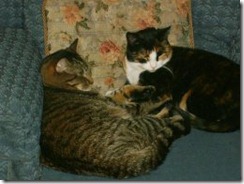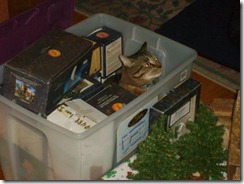2012 was a great year for musical projects, having crossed off some shows from my “bucket list.”
The year started with ANNIE at Main Street Theater, in Sayreville. Admittedly, this show grew on me as I was working on it. It’s a rather sweet show; and it does have some depth of feeling. The music was fun to teach and to play. A fun part of it was being able to work with my wife and son. She played the role of Grace; and he was the stage manager.
Then I moved on to GYPSY, which had been in the works for nearly a year. Performed at Playhouse22 in East Brunswick; and I worked with a director for the first time who had a very clear vision and was a master collaborator. This was a complete joy to work on … the music being so iconic at times – there are songs that everybody seems to know. The orchestra we assembled was phenomenal … after nearly every performance folks would come up to me to compliment the orchestra and its sound.
While performing GYPSY, I helped a friend with a fund raising event at Villagers Theater in Somerset. This project included songs from shows that I had not done (and likely won’t do) as well as an opportunity to work with actors that I had only seen. The talent collected for this event was phenomenal. And it was during rehearsals for this special event that I met someone who would become a good friend and who would offer me the opportunity to music direct one of my favorite shows (more on that later).
The Summer saw my return to the Young Adult Drama Group (YADG), which is sponsored by the North Brunswick Township Department of Parks and Recreation. This is something that I look forward to each year – getting to work with young people ranging in ages from 13 to 23. I’ve known many of them over the course of these four short years, and they all are wonderfully talented young people. This year’s production was FOOTLOOSE. … … not my favorite of musicals, yet it does have its moments, and the young people thoroughly enjoyed it.
As soon as the Summer project with YADG was completed I moved on to SWEET CHARITY – also at Main Street Theater. I remember seeing the Broadway revival with Debbie Allen; and I fell in love with the music then. Here was my chance to really dig into this great score. In spite of challenges during rehearsals – such as having several actors drop out and others having some health issues – this was a total blast to do. WOW! What a score! (Got to work with my son yet again, as he served as stage manager)
At various times in the first half of the year I was fortunate to be called by TWO RIVER THEATER, in Red Bank. I accompanied Tony Award winning actor, Chuck Cooper, for a special event there; and played for their Equity auditions as well. I hope that I get to return again and again and again in the following years.
SWEET CHARITY was coming to an end and that’s when I started work on INTO THE WOODS. How I got this gig was fortunate indeed. It came about from the fund raising event I did earlier in the year … having met someone who would become a dear friend of mine, JC. He asked me if I was interested. HELLZ YEAH! This was a remarkably rewarding experience all the way ‘round for me. It marked my return to Villagers Theater in Somerset; and I got to work with some of the most talented actors I’ve ever known. (I know that many other say, “Oh this is such a talented group” and such; however, in this particular case – it is DAMNED TRUE! The company of actors I worked with on this show were nothing less than astounding). And to top it off, it was a ‘family affair’ as well … with my wife playing the part of Jack’s Mother, and my son working on the stage crew.
I ended the year not as a musician or music director, but as an actor … reprising the role of Jacob Marley in A CHRISTMAS CAROL at Playhouse22. This was their 16th year of doing this play – and it marked my fourth year with it. Another blessing in this production was being able to share the stage with my son, who reprised his role of Peter Cratchet.
So 2012 was a great year – full of great projects … making new friendships … being part of some real magic on stage here in NJ. And I’m already working on 2013, preparing for my next project which is yet another Sondheim musical.
I am blessed indeed to have had all these opportunities and all these great theater friends.



















